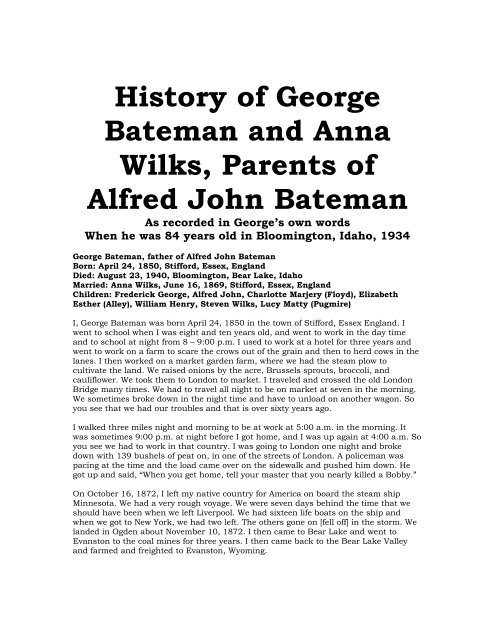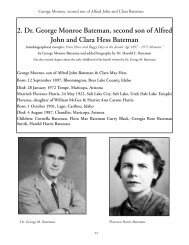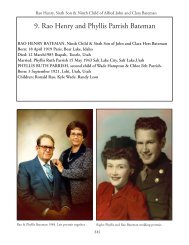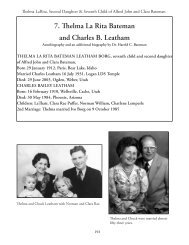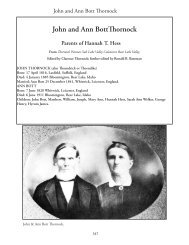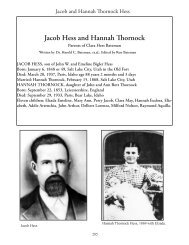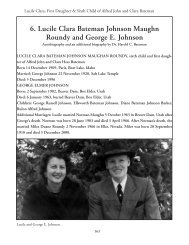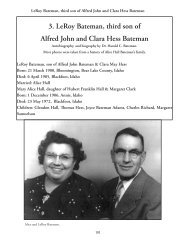History of George Bateman and Anna Wilks ... - Bateman Family
History of George Bateman and Anna Wilks ... - Bateman Family
History of George Bateman and Anna Wilks ... - Bateman Family
Create successful ePaper yourself
Turn your PDF publications into a flip-book with our unique Google optimized e-Paper software.
<strong>History</strong> <strong>of</strong> <strong>George</strong><br />
<strong>Bateman</strong> <strong>and</strong> <strong>Anna</strong><br />
<strong>Wilks</strong>, Parents <strong>of</strong><br />
Alfred John <strong>Bateman</strong><br />
As recorded in <strong>George</strong>’s own words<br />
When he was 84 years old in Bloomington, Idaho, 1934<br />
<strong>George</strong> <strong>Bateman</strong>, father <strong>of</strong> Alfred John <strong>Bateman</strong><br />
Born: April 24, 1850, Stifford, Essex, Engl<strong>and</strong><br />
Died: August 23, 1940, Bloomington, Bear Lake, Idaho<br />
Married: <strong>Anna</strong> <strong>Wilks</strong>, June 16, 1869, Stifford, Essex, Engl<strong>and</strong><br />
Children: Frederick <strong>George</strong>, Alfred John, Charlotte Marjery (Floyd), Elizabeth<br />
Esther (Alley), William Henry, Steven <strong>Wilks</strong>, Lucy Matty (Pugmire)<br />
I, <strong>George</strong> <strong>Bateman</strong> was born April 24, 1850 in the town <strong>of</strong> Stifford, Essex Engl<strong>and</strong>. I<br />
went to school when I was eight <strong>and</strong> ten years old, <strong>and</strong> went to work in the day time<br />
<strong>and</strong> to school at night from 8 – 9:00 p.m. I used to work at a hotel for three years <strong>and</strong><br />
went to work on a farm to scare the crows out <strong>of</strong> the grain <strong>and</strong> then to herd cows in the<br />
lanes. I then worked on a market garden farm, where we had the steam plow to<br />
cultivate the l<strong>and</strong>. We raised onions by the acre, Brussels sprouts, broccoli, <strong>and</strong><br />
cauliflower. We took them to London to market. I traveled <strong>and</strong> crossed the old London<br />
Bridge many times. We had to travel all night to be on market at seven in the morning.<br />
We sometimes broke down in the night time <strong>and</strong> have to unload on another wagon. So<br />
you see that we had our troubles <strong>and</strong> that is over sixty years ago.<br />
I walked three miles night <strong>and</strong> morning to be at work at 5:00 a.m. in the morning. It<br />
was sometimes 9:00 p.m. at night before I got home, <strong>and</strong> I was up again at 4:00 a.m. So<br />
you see we had to work in that country. I was going to London one night <strong>and</strong> broke<br />
down with 139 bushels <strong>of</strong> peat on, in one <strong>of</strong> the streets <strong>of</strong> London. A policeman was<br />
pacing at the time <strong>and</strong> the load came over on the sidewalk <strong>and</strong> pushed him down. He<br />
got up <strong>and</strong> said, “When you get home, tell your master that you nearly killed a Bobby.”<br />
On October 16, 1872, I left my native country for America on board the steam ship<br />
Minnesota. We had a very rough voyage. We were seven days behind the time that we<br />
should have been when we left Liverpool. We had sixteen life boats on the ship <strong>and</strong><br />
when we got to New York, we had two left. The others gone on [fell <strong>of</strong>f] in the storm. We<br />
l<strong>and</strong>ed in Ogden about November 10, 1872. I then came to Bear Lake <strong>and</strong> went to<br />
Evanston to the coal mines for three years. I then came back to the Bear Lake Valley<br />
<strong>and</strong> farmed <strong>and</strong> freighted to Evanston, Wyoming.
For forty-five years, I was in the bishopric <strong>of</strong> the Bloomington Ward <strong>and</strong> was counselor<br />
to William Hulme for some time <strong>and</strong> a teacher for over fifty years in the Bloomington<br />
Ward. I have spent the last <strong>of</strong> my time in farming in the Bear Lake Valley. I am writing<br />
on February 25, 1934 in my eighty-fourth year.<br />
<strong>George</strong> <strong>Bateman</strong><br />
by <strong>George</strong>’s 3 rd son, William Henry <strong>Bateman</strong>, May 14, 1967<br />
<strong>George</strong> <strong>Bateman</strong>, his wife, <strong>Anna</strong> <strong>Wilks</strong> <strong>and</strong> their son Fred came from Engl<strong>and</strong> to<br />
America accompanied by their parents, aunts <strong>and</strong> uncles, <strong>and</strong> brothers <strong>and</strong> sisters. At<br />
times their faith was at a low ebb because they sailed six weeks on the Atlantic in an<br />
old sail boat.<br />
After l<strong>and</strong>ing on the east coast, they all traveled directly to Ogden, Utah. While living<br />
there a short while, Joshua Jarvis came to Ogden with a pocketful <strong>of</strong> soil from Bear<br />
Lake County, Idaho. He encouraged <strong>George</strong> to move to Bloomington, Idaho to purchase<br />
a farm. <strong>George</strong> had been a first class farmer in Engl<strong>and</strong>, so he willingly left for<br />
Bloomington with Mr. <strong>and</strong> Mrs. Jarvis <strong>and</strong> his family. Because <strong>of</strong> the shortage <strong>of</strong><br />
blankets, the two women slept in the wagon <strong>and</strong> the men outside by the fire in<br />
Emigration Canyon.<br />
When they reached Bloomington, <strong>George</strong> only had one shirt <strong>and</strong> fifty cents to his name.<br />
The next day, he started walking to Almy, Wyoming which was 70 miles away, to work<br />
in the Almy Mine. He returned to Bloomington in the spring with $100 in gold. This was<br />
quite a bit <strong>of</strong> money compared to his previous wage in Engl<strong>and</strong> which had consisted <strong>of</strong><br />
twenty-five cents, a glass <strong>of</strong> beer, <strong>and</strong> a piece <strong>of</strong> cheese each day.<br />
Upon his arrival in Bloomington, the Probate Judge, <strong>George</strong> Osmond deeded him a halfacre<br />
plot <strong>of</strong> l<strong>and</strong>. He built a nice split level home. This was to be their permanent home<br />
after working a few more years in the Almy Mine in Wyoming. Almy was where his<br />
second son, John was born.<br />
After finally settling in Bloomington, <strong>George</strong> set up a freight business in Afton,<br />
Wyoming. This provided a modest yet sufficient means to support his family. Often, he<br />
would take his sons with him in the loaded horse-driven wagon. They would stop in<br />
Garden City, Utah at Chris Hansen’s; in Laketown, Utah at Joe Lamborn’s; in<br />
R<strong>and</strong>olph, Utah, at Joe Carbett’s Ranch; <strong>and</strong> in Evanston, Wyoming at Barney Fox’s<br />
Camp House.<br />
The individual fare for these men to sleep, cook <strong>and</strong> have their horses fed was only<br />
thirty-five cents. When their goods- cheese, fish, wheat, eggs, chicken feed- were<br />
delivered they would start back with a load <strong>of</strong> sugar. This could be delivered for fifty<br />
cents a hundred. Each two-week interval trip made them $25.<br />
Besides being busy with freighting, <strong>George</strong> was a farmer, blacksmith, horse trader <strong>and</strong><br />
carpenter. He loved to keep busy <strong>and</strong> accomplish worth-while projects. The evenings<br />
were <strong>of</strong>ten spent reading.<br />
His personality <strong>of</strong>ten radiated a love for others. He would <strong>of</strong>ten say “Always speak to the<br />
other person, even if the other person doesn’t speak first.” He seemed to have a joke for<br />
every occasion. “He was much like Will Rogers,” remarked his third son William Henry.<br />
His gr<strong>and</strong>children eagerly anticipated his treats <strong>of</strong> c<strong>and</strong>y <strong>and</strong> toys after he’d return from<br />
Evanston.
Although only 5’8” <strong>and</strong> <strong>of</strong> a slight build, <strong>George</strong> was very strong physically <strong>and</strong><br />
spiritually. He carried four bushels <strong>of</strong> wheat while working in Engl<strong>and</strong>. He never<br />
seemed to complain <strong>of</strong> sickness. While resting, his death came quickly with no pain.<br />
Spiritually, he was a pillar <strong>of</strong> strength. He was a counselor to the Bloomington Ward<br />
bishop. His love <strong>of</strong> church books exhibited his pr<strong>of</strong>ound knowledge <strong>of</strong> church doctrine.<br />
His s<strong>of</strong>t-spoken mannerisms attracted listeners with an intense feeling while he spoke.<br />
Humility <strong>and</strong> kindness also were his virtues.<br />
Two <strong>of</strong> his seven children were still living in 1967. They were Lucy Pugmire 76 <strong>of</strong> Salt<br />
Lake City, <strong>and</strong> William Henry <strong>Bateman</strong> 81 <strong>of</strong> Brigham City, Utah. His oldest son, Fred<br />
died at the age <strong>of</strong> 75, John died at 86, Margery died at 80, Lizzie died at 84, <strong>and</strong><br />
Stephen died at 76. (Printed in <strong>History</strong> <strong>of</strong> Bear Lake Pioneers, p. 63)<br />
<strong>George</strong> <strong>Bateman</strong> <strong>and</strong> <strong>Anna</strong> <strong>Wilks</strong> were the parents <strong>of</strong> my father, Alfred John <strong>Bateman</strong>.<br />
<strong>George</strong> was born in Stifford, Essex, Engl<strong>and</strong>, the eldest son <strong>of</strong> Alfred <strong>Bateman</strong> <strong>and</strong><br />
Elizabeth Wiffin on 24 April 1850 <strong>Anna</strong> was born at Lindsell, Essex, Engl<strong>and</strong> 16 June<br />
1849 to John <strong>Wilks</strong> <strong>and</strong> Charlotte Terry Turner. <strong>George</strong> was baptized 23 October 1863<br />
<strong>and</strong> <strong>Anna</strong> received hers 19 June 1859 They were married at Stifford, Essex, Engl<strong>and</strong>,<br />
16 June 1869 Both were endowed 2 October 1876 <strong>and</strong> she was sealed to her husb<strong>and</strong><br />
the same day at an Endowment House.<br />
In studying the history <strong>of</strong> Alfred <strong>and</strong> his eldest son, <strong>George</strong>, one would conclude they<br />
were very close <strong>and</strong> worked in complete harmony with each other. Both men were truly<br />
converted to the Church <strong>of</strong> Jesus Christ <strong>of</strong> Latter—day Saints. Neither man nor their<br />
spouses seemed to harbor any doubts concerning the validity <strong>and</strong> truthfulness that Joseph<br />
Smith was a Prophet <strong>of</strong> God <strong>and</strong> was used as an instrument in restoring His Gospel again<br />
to the earth. Priorities <strong>of</strong> both men seemed identical in their willingness to sacrifice all<br />
worldly emoluments for the building up <strong>of</strong> the Lord’s Kingdom here in the earth <strong>and</strong> if<br />
necessary to give their very lives to this end. The agreement <strong>of</strong> <strong>George</strong> <strong>and</strong> his wife,<br />
<strong>Anna</strong> to acquiesce in being the first <strong>of</strong> their family to America in a tremendously risky<br />
adventure points this up. Alfred <strong>and</strong> his wife, Esther agreed to assist them <strong>and</strong> to send<br />
their eighteen year old son, the following year <strong>and</strong> to come themselves two years later in<br />
1874 portrayed great faith, courage <strong>of</strong> all <strong>of</strong> then in making these hard decisions under<br />
the existing difficult circumstances proved the strength <strong>of</strong> their testimonies.<br />
The manner in which <strong>George</strong> <strong>and</strong> <strong>Anna</strong> were willing to leave their mother <strong>and</strong> father<br />
<strong>and</strong> loved ones as well as their native country indicated great courage <strong>and</strong> a strong<br />
testimony <strong>and</strong> love for the Church. They traveled by transportation available to the<br />
great seaport city <strong>of</strong> Liverpool to take passage on the steamship Minnesota, 16 April<br />
1872 to cross the stormy Atlantic Ocean. They must have suffered since the<br />
conveniences were few then <strong>and</strong> some misgivings <strong>and</strong> fears must have been their lot<br />
during the dangerous ocean voyage. Much <strong>of</strong> the time during the crossing must have<br />
been spent on their knees in prayerful supplication to the Lord for a safe journey since<br />
treacherous storms almost sank the ship. They finally arrived safely into the New York<br />
harbor seven days behind schedule. <strong>George</strong> said it was a very rough voyage <strong>and</strong> they<br />
had their h<strong>and</strong>s full taking care <strong>of</strong> baby <strong>George</strong> Frederick during the hectic weeks on<br />
the stormy ocean. How Gr<strong>and</strong>father <strong>and</strong> Gr<strong>and</strong>mother <strong>Bateman</strong> dared to take this<br />
adventurous move to America can only be explained by courage born <strong>of</strong> great faith <strong>and</strong><br />
testimony <strong>of</strong> the truthfulness <strong>of</strong> the Gospel <strong>and</strong> the mercy <strong>of</strong> God. <strong>George</strong> was but a<br />
young man <strong>of</strong> twenty—two with <strong>Anna</strong> about a year older. When the good ship<br />
Minnesota left Liverpool, Engl<strong>and</strong>, it had sixteen life boats <strong>and</strong> on its arrival into New<br />
York, it only had two left which meant that fourteen had been lost during the bitter cold<br />
storms encountered during the crossing.
They stayed in New York until tickets could be purchased for the train ride in unclean<br />
railroad coaches to Ogden, Utah where they arrived very tired on 10 <strong>of</strong> November 1872<br />
Here they were met by Joshua Jarvis who shortly arrived in a wagon drawn by a team<br />
<strong>of</strong> horses from Bloomington, Bear Lake County, Idaho. Joshua brought a pocket full <strong>of</strong><br />
Bear Lake Valley dirt to show <strong>George</strong> the quality <strong>of</strong> the soil in the Idaho valley. With this<br />
as an argument, he suggested that <strong>George</strong> <strong>and</strong> family come with him to Bloomington<br />
<strong>and</strong> buy a farm. <strong>George</strong> had been a productive farmer in Engl<strong>and</strong> <strong>and</strong> was favorably<br />
impressed so he <strong>and</strong> <strong>Anna</strong> decided to accompany the Jarvises to Bloomington. Hardships<br />
were experienced along the way from the rough bumpy unimproved roads <strong>and</strong><br />
cold. At nights, the women <strong>and</strong> child slept in the wagon <strong>and</strong> because <strong>of</strong> a shortage <strong>of</strong><br />
bedding, the men made their beds near the fire during the overnight stops.<br />
On reaching Bloomington, Idaho <strong>George</strong> had but one shirt <strong>and</strong> fifty cents in his pocket.<br />
Finding no work there the next day, he began a long walk <strong>of</strong> over seventy miles to Almy,<br />
Uinta, Wyoming, one mile north <strong>of</strong> Evanston to secure work in the Union Pacific<br />
railroad coal mines. He left his wife <strong>and</strong> son in Bear Lake with relatives while he labored<br />
all winter in the mines. He returned in the spring with over $100 in gold which was a<br />
sizeable sum <strong>of</strong> money then. His wages in the Wyoming mining town was better than<br />
his former English wage <strong>of</strong> twenty— five cents a day, a piece <strong>of</strong> cheese <strong>and</strong> a glass <strong>of</strong><br />
ale. -<br />
When <strong>George</strong> returned to Bloomington, Bear Lake County, Idaho, the Probate Judge,<br />
<strong>George</strong> Osmond deeded him a half an acre plot <strong>of</strong> l<strong>and</strong>. He being a man <strong>of</strong> versatile<br />
skills used his talents to build a split level home, a barn, sheds <strong>and</strong> a corral on the<br />
l<strong>and</strong>. A sizeable portion <strong>of</strong> it was used for a garden spot <strong>and</strong> for a fruit orchard. He was<br />
an accomplished farmer gardener, blacksmith, horse trader <strong>and</strong> possessed expertise in<br />
other areas. He was a devoted student <strong>of</strong> the Scriptures <strong>and</strong> an avid reader <strong>of</strong> them. He<br />
worked several years in the Almy mines in order to secure a nest egg with which to<br />
construct his home on the newly acquired property. While <strong>George</strong> <strong>and</strong> <strong>Anna</strong> were living<br />
in Almy, Uinta, Wyoming my father, Alfred John <strong>Bateman</strong> was born on 11 July 1874 to<br />
join Frederick <strong>George</strong> as a playmate. Their one half an acre parcel <strong>of</strong> l<strong>and</strong> was located<br />
on the West side <strong>of</strong> the street just a short distance North <strong>of</strong> the Bloomington LDS Ward<br />
Chapel. Their new home became a permanent place <strong>of</strong> residence <strong>and</strong> where their last<br />
five children were born <strong>and</strong> raised to adulthood. . .<br />
It is not difficult to see where my father, Alfred John <strong>Bateman</strong> gained his interest <strong>and</strong><br />
love <strong>of</strong> horses <strong>of</strong> all kinds. <strong>George</strong> <strong>Bateman</strong>, his father was his teacher <strong>and</strong> brought this<br />
feeling with him from old Engl<strong>and</strong>. We stated earlier in this history that the one half<br />
acre l<strong>and</strong> parcel had needed space for home, garden <strong>and</strong> corral. The parents learned<br />
their l<strong>and</strong>scaping well in old Engl<strong>and</strong> their home area was decorated in the tradition <strong>of</strong><br />
their former home. Their planning was geared to beauty <strong>and</strong> utility. Productive fruit<br />
trees <strong>and</strong> decorative shrubbery not only provided beauty but fruit for canning. The yard<br />
reflected their culture <strong>and</strong> the true quality <strong>of</strong> these industrious people who had to work<br />
so hard all <strong>of</strong> their lives. The place became literally one teeming with milk, honey <strong>and</strong><br />
beauty. The <strong>George</strong> <strong>Bateman</strong>s were indeed meticulous home makers inside <strong>and</strong> outside<br />
their home.<br />
After finally getting settled in Bloomington, <strong>George</strong> <strong>Bateman</strong> established a freighting<br />
business which included Afton, Wyoming <strong>and</strong> Bear Lake County extending southward<br />
including such communities as Woodruff1 R<strong>and</strong>olph with Evanston being the terminal<br />
point. The income was modest but sufficient to support the family. He <strong>of</strong>ten took my<br />
father, Alfred John <strong>and</strong> his other sons with him on the wagon loaded with produce<br />
including sugar. Stops were made at various settlements along the route to Evanston.
Some <strong>of</strong> the specific stopping places mentioned in the records included Chris Hansen’s<br />
at Garden City; Joe Lamborn’s in Laketown. Joe Corbett’s in R<strong>and</strong>oph; <strong>and</strong> Barney<br />
Foxe’ s in Evanston. The cost <strong>of</strong> sleeping, cooking <strong>and</strong> having their horses fed was 35<br />
cents. After delivering the load <strong>of</strong> cheese, fish, wheat eggs, <strong>and</strong> chicken feed, the wagon<br />
was loaded with sacks <strong>of</strong> sugar which were delivered for 50 cents per 100 pounds. I<br />
personally recall when but a small lad, gr<strong>and</strong>father <strong>Bateman</strong> delivering large sacks <strong>of</strong><br />
sugar to our home. The sugar was enclosed in a white cotton sack with the outside one<br />
made <strong>of</strong> heavy burlap. Somehow having these huge bags <strong>of</strong> sugar gave a family a sense<br />
<strong>of</strong> security. The sacks <strong>of</strong> sugar <strong>and</strong> flour were stored in large bins <strong>and</strong> when available in<br />
steel drums.<br />
<strong>George</strong> <strong>Bateman</strong> raised his produce in a large garden in order to supplement his<br />
freighting income. <strong>George</strong> raised additional income as a blacksmith <strong>and</strong> horse trader.<br />
He wasted but little time loafing <strong>and</strong> every moment was productively used. Many <strong>of</strong> his<br />
evening hours by a kerosene lamp were spent studying the Gospel Scriptures <strong>and</strong> he<br />
knew them well. William Henry <strong>Bateman</strong>, his third son, said his father’s personality<br />
radiated love. It was always his policy to always greet others first. He was a jester <strong>and</strong><br />
full <strong>of</strong> jokes 1 according to his son. He was compared to Will Rogers <strong>and</strong> on his regular<br />
treks to Evanston; he popularized himself with some <strong>of</strong> his gr<strong>and</strong>children by bringing<br />
them toys <strong>and</strong> c<strong>and</strong>y. They must have been given to Fred <strong>and</strong> Maggie <strong>Bateman</strong>’s family<br />
since I do not ever remember him giving our family anything. I did not get to know him<br />
well enough to detect his humor but I can personally verify that his tongue could be<br />
tart. One occasion when Charlotte’s parents were with us on a trip through Bear Lake,<br />
we stopped for a visit with him. He turned to me to inquire if I knew Samuel <strong>Bateman</strong>,<br />
his brother had passed away. I said no. He then crisply wondered if I knew that Jesus<br />
Christ had been crucified. I honestly answered that I did not know Samuel <strong>Bateman</strong><br />
<strong>and</strong> had never to my knowledge ever heard <strong>of</strong> him previously so could hardly be<br />
expected to know <strong>of</strong> this event . . .<br />
His s<strong>of</strong>t voice <strong>and</strong> gentle mannerisms made a strong <strong>and</strong> lasting impression on his<br />
listeners <strong>and</strong> left them in a positive mood. He had a reputation for being kind <strong>and</strong><br />
gentle but he could also be firm when the occasion justified it.<br />
The interior <strong>of</strong> their home was always immaculate <strong>and</strong> decorated in pleasing decor.<br />
Gr<strong>and</strong>mother could be blunt <strong>and</strong> straight forward but never a hypocrite. She was a lady<br />
<strong>of</strong> culture, expert housekeeper <strong>and</strong> manager <strong>of</strong> the household finances. She was an<br />
excellent cook . . . He gourmet <strong>and</strong> especially her Christmas pudding were a delight to<br />
the taste buds. They loved their home <strong>and</strong> this feeling was reflected in it. <strong>Anna</strong> was neat<br />
<strong>and</strong> tidy in her personal attire <strong>and</strong> wore good clothes. She used good taste in her<br />
selection <strong>of</strong> them. This was true <strong>of</strong> her husb<strong>and</strong>, also. In her dress <strong>and</strong> mannerisms,<br />
she reminded me <strong>of</strong> Queen Victoria <strong>of</strong> her native Great Britain.<br />
Their family went enmasse to Sacrament meetings <strong>and</strong> to other ward meetings such as<br />
the Bear Lake Stake conferences held in the pretentious tabernacle located in Paris. At<br />
the monthly testimony meetings, Alfred bore a strong one in his loud booming voice<br />
while his son, <strong>George</strong> did likewise except in a more subdued voice. Both men were avid<br />
students <strong>of</strong> the Church orthodoxy.<br />
I can still see in my memory, Gr<strong>and</strong>mother <strong>Anna</strong> <strong>Bateman</strong> traveling the rough dusty<br />
roads <strong>of</strong> Bear Lake riding in her small black topped buggy drawn by an attractive horse<br />
with a star on its head. She was a traveler who regularly shopped around the valley <strong>and</strong><br />
visited with her loved ones. She was affectionately devoted to her family <strong>and</strong> church.<br />
She hardly thought anyone was good enough to marry one <strong>of</strong> her children. Mother was<br />
annoyed about this feeling <strong>and</strong> confided her feelings about it to me . . .
The family <strong>of</strong> <strong>George</strong> <strong>and</strong> <strong>Anna</strong> consisted <strong>of</strong> seven: four sons <strong>and</strong> three daughters. All <strong>of</strong><br />
the sons were fine looking giants approximately six feet four inches or taller <strong>and</strong> all<br />
weighed over 200 pounds each yet none <strong>of</strong> them were fat but quite heavily muscled <strong>and</strong><br />
well-built. The daughters were about five <strong>and</strong> a half feet tall <strong>and</strong> all were attractive<br />
proud ladies. A brief description <strong>of</strong> each <strong>of</strong> the children is herewith presented to the<br />
best <strong>of</strong> my memory.<br />
Frederick <strong>George</strong>, the first born arrived in South Ockendon, Essex, Engl<strong>and</strong>, 13 August<br />
1871. He was a babe in arms <strong>of</strong> over a year old when his parents migrated to America.<br />
His early education was received in Bloomington <strong>and</strong> in Bear Lake <strong>and</strong> he attended the<br />
Brigham Young College in Logan, Utah. He was financially supported by his parents on<br />
an LDS mission for two years to Great Britain. While on his mission, he met Margaret<br />
Hargreave, with whom he fell in love <strong>and</strong> later married her in the LDS temple (6 Sep<br />
1901). Fred later taught school but turned to farming since he did not like teaching.<br />
Later he operated a coal company in Montpelier, Idaho. Their family consisted <strong>of</strong> six<br />
sons. Brady, one <strong>of</strong> their young sons was accidentally killed with a gun shot wound in<br />
his abdomen which caused sadness <strong>and</strong> shock in the family. Gilbert <strong>and</strong> Edwin were<br />
their two eldest boys. Fred <strong>and</strong> his wife were active in the Church all their lives <strong>and</strong><br />
both are resting in the Montpelier, Idaho cemetery. (He died 16 March 1944.)<br />
Alfred John <strong>Bateman</strong>, my father was born 11 July 1874 in Almy, Uinta, Wyoming, the<br />
second son <strong>of</strong> <strong>George</strong> <strong>Bateman</strong> <strong>and</strong> <strong>Anna</strong> <strong>Wilks</strong>. He married Clara May Hess at<br />
Bloomington LDS Ward, 14 February 1895 but later solemnized in the Logan LDS<br />
Temple for all time <strong>and</strong> eternity, 10 October 1895. Nine children were born to this<br />
marriage. Both parents are resting in the Wellsville, Cache County, Utah cemetery. He<br />
died 7 March 1961. More data about them is in another chapter.<br />
Charlotte Marjorie <strong>Bateman</strong> was the first <strong>of</strong> their children to be born in Bloomington, 27<br />
January 1878. She married <strong>George</strong> Floyd, a fine, kind man who was a farmer but was<br />
not too robust <strong>and</strong> he passed away when rather young <strong>and</strong> left his wife <strong>and</strong> a family <strong>of</strong><br />
four. She experienced many hard struggles to make ends meet. Her husb<strong>and</strong> is buried<br />
in the St. Charles, Idaho cemetery. Marjery later went to Hagerman, Idaho to be near<br />
her daughter, Iris Floyd Pugmire where she met <strong>and</strong> married a Mr. Anderson. Two <strong>of</strong><br />
her children were deceased by 1979 <strong>and</strong> she passed away <strong>and</strong> is buried in Hagerman,<br />
Idaho.<br />
Elizabeth Esther <strong>Bateman</strong> was born in Bloomington, Idaho, 13 April 1880. She married<br />
<strong>George</strong> Alley, 18 September 1901. They had two daughters, one <strong>of</strong> which was still living<br />
in 1979, but not well. I gained the impression from reports bout <strong>George</strong> that he lacked<br />
substance <strong>and</strong> character. He was said to have lost his inheritance which was gained<br />
from a ranch. In any case, he failed to properly support his wife <strong>and</strong> family. Elizabeth<br />
<strong>and</strong> her two daughter suffered many hardships. Both are deceased <strong>and</strong> are buried in<br />
the Laketown, Utah cemetery. She died 27 April 1963. Dr. Harold <strong>Bateman</strong> spoke at her<br />
funeral services.<br />
William Henry <strong>Bateman</strong> was born in Bloomington, Idaho, 9 September 1885. He<br />
married Vesta Thompson 14 July 1908. They had seven children. He was a successful<br />
business man <strong>and</strong> farmer who lived with his wife at Brigham City, Utah. Both he <strong>and</strong><br />
his wife died there <strong>and</strong> are buried in the Bloomington cemetery. She died 2 Sep 1973.<br />
Steven <strong>Wilks</strong> <strong>Bateman</strong> was born in Bloomington, 4 September 1887. He married<br />
Blanche Innes <strong>of</strong> Paris, Idaho 1 April 1912. They had eight daughters. He was a logger,<br />
horseman <strong>and</strong> an all around h<strong>and</strong>y man. He <strong>and</strong> his wife passed away in Ogden, Utah<br />
<strong>and</strong> they are both buried in the city cemetery. He died 15 may 1964. Dr. Harold
<strong>Bateman</strong> spoke at both <strong>of</strong> their services.<br />
Lucy Matty, the youngest child was born in Bloomington 3 February 1891. She was a<br />
pretty girl who did considerable singing in public. She married Archie Pugmire, a<br />
railroad man 16 November 1911. They had two daughters who lived in Salt Lake City.<br />
Both Lucy (d. 26 Mar 1969) <strong>and</strong> Archie (d. 6 Sep 1963) are deceased <strong>and</strong> are buried in a<br />
Salt Lake City cemetery.<br />
Ann <strong>Wilks</strong> passed away, 13 June 1927 in Bloomington, Bear Lake County, Idaho <strong>and</strong><br />
<strong>George</strong> <strong>Bateman</strong> died 23 August 1940 also in Bloomington. Both are resting about two<br />
thirds <strong>of</strong> the distance through the cemetery just north <strong>of</strong> the main entrance road jus a<br />
short distance west <strong>of</strong> the Little Lamb monument on the grave <strong>of</strong> my little baby brother,<br />
Russell Arthur <strong>Bateman</strong>. <strong>Anna</strong>’s parents’, John <strong>Wilks</strong> <strong>and</strong> his wife, Charlotte Terry<br />
Turner <strong>Wilks</strong> are located nearby; just north <strong>of</strong> the little lamb.<br />
Alfred <strong>Bateman</strong> <strong>and</strong> Esther Wiffin,<br />
Gr<strong>and</strong>parents <strong>of</strong> Alfred John <strong>Bateman</strong><br />
By Maud T. <strong>Bateman</strong><br />
Alfred <strong>Bateman</strong> was born in the town <strong>of</strong> Orsett, Engl<strong>and</strong> December 8, 1825. He was the<br />
son <strong>of</strong> James <strong>Bateman</strong> <strong>and</strong> Charlotte Dalliday. In the year <strong>of</strong> 1848, Alfred <strong>Bateman</strong> <strong>and</strong><br />
Esther Elizabeth Wiffin were married. She was born July 17, 1830 at Stafford, Engl<strong>and</strong>.<br />
She was the daughter <strong>of</strong> James Wiffin <strong>and</strong> Rosm<strong>and</strong> Green.<br />
News <strong>of</strong> a new religion was coming to Engl<strong>and</strong> at the time. In their own home they<br />
accepted the Church <strong>of</strong> Jesus Christ <strong>of</strong> Latter-day Saints missionaries, despite the fact<br />
that Esther’s parents were opposed to the Mormon Church <strong>and</strong> warned her that she<br />
would never be welcome to enter their home again. They chose to become members <strong>of</strong><br />
what they felt was the true church on April 1, 1854 <strong>and</strong> were baptized by Charles W.<br />
Penrose.<br />
The uppermost thought in Alfred’s mind was to move his family to Zion. By the year <strong>of</strong><br />
1872, they had a family <strong>of</strong> ten living children. They had saved enough money to send<br />
their eldest son, <strong>George</strong> <strong>Bateman</strong>, his wife <strong>and</strong> baby to America. He was twenty-two<br />
years old. The following year they sent their fourth child, a son who was eighteen to join<br />
his brother <strong>George</strong> at Evanston, Wyoming.<br />
In the year <strong>of</strong> 1874 Alfred <strong>and</strong> his wife Esther Elizabeth with six <strong>of</strong> their children sailed<br />
on the old Wyoming from Liverpool to America. They had sad hearts when it became<br />
necessary to leave their two oldest daughters who were married in Engl<strong>and</strong>. They spent<br />
three weeks on the ocean.<br />
Alfred spent the next four years as stable boss at Evanston, Wyoming where horses <strong>and</strong><br />
mules used for freighting were cared for.<br />
In January 1878 they left by team for Bloomington, Idaho. He spent his time raising<br />
garden produce <strong>and</strong> freighting it by team to Evanston.<br />
Esther, his wife, died February 7, 1904 at Bloomington at the age <strong>of</strong> 70. Alfred died<br />
December 8, 1928 at Bloomington on his 103 rd birthday. He was one <strong>of</strong> the oldest<br />
pioneers. The children born to them were: <strong>George</strong>, Eliza, Esther, Alfred James, James<br />
Alfred, Charlotte Wiffen, Elizabeth, Herbert, Alice Elizabeth, <strong>and</strong> Mary Ann Rosamond.<br />
(<strong>History</strong> <strong>of</strong> Bear Lake Pioneers, pp. 62-63)
“Alfred <strong>Bateman</strong> Passes” [obituary]<br />
Bear Lake County lost its oldest resident Sunday, December 9, 1928 when Alfred<br />
<strong>Bateman</strong>, 103 years <strong>of</strong> age, passed to the great beyond, but one day following his<br />
birthday, December 8, 1825. He retained a clear memory to the end <strong>and</strong> fell into a sleep<br />
without any great deal <strong>of</strong> previous illness, thus closing the last chapter <strong>of</strong> not only the<br />
County’s oldest citizen but perhaps the oldest member in the L.D.S. Church. He was<br />
born before the introduction <strong>of</strong> the steam railroad into building <strong>and</strong> developing <strong>of</strong> this<br />
valley, <strong>and</strong> many other developments <strong>of</strong> great not have developed since his birth.<br />
Like a mighty oak in a forest weathering the storms <strong>of</strong> ages, so had this distinguished<br />
pioneer been preserved against life’s adversities until the day <strong>of</strong> his death. He<br />
comm<strong>and</strong>ed the respect <strong>and</strong> enjoyed the friendship <strong>of</strong> all, <strong>and</strong> he leaves to the present<br />
generation an example that is indeed worthy <strong>of</strong> emulation. He has left the impress <strong>of</strong> his<br />
life upon the history <strong>of</strong> the valley. Mr. <strong>Bateman</strong> was born in Essex, Engl<strong>and</strong> <strong>and</strong><br />
embraced the faith <strong>of</strong> the Mormon Church when a lad. His life has been varied <strong>and</strong><br />
interesting. He crossed the Atlantic on the steamship Wyoming, <strong>and</strong> came west when it<br />
was a vast unbroken country <strong>of</strong> mountain <strong>and</strong> plain, <strong>of</strong> hill, <strong>and</strong> valley, <strong>and</strong> its l<strong>and</strong>s<br />
were largely uncultivated. The deceased took up his abode within its borders, locating<br />
first at Evanston, Wyoming, <strong>and</strong> later at Bloomington, where he contributed largely<br />
towards this county. Matches <strong>and</strong> coal oil lamps were unknown.<br />
In Wyoming he was engaged in mining, being employed by the Union Pacific in the old<br />
Wyoming mine, one <strong>of</strong> the oldest coal mines in that state. He assisted in opening mine<br />
number four.<br />
In Engl<strong>and</strong> he worked in chalk mines, cradled wheat, as modern farming machinery<br />
was not even dreamed <strong>of</strong> at that time, <strong>and</strong> trapped mole rats, a rodent similar to<br />
squirrels in this country. He operated a trapping line a distance <strong>of</strong> twenty miles for<br />
various farms. Following these various occupations, he made a substantial living while<br />
still a native <strong>of</strong> Engl<strong>and</strong>.<br />
He was married to Miss Esther Wiffin, who preceded him in death by twenty-eight<br />
years. Their direct descendants number four hundred <strong>and</strong> fifty. The deceased has seen<br />
five generations <strong>and</strong> his eldest son, who is still living, is seventy-eight years old. An idea<br />
<strong>of</strong> his advanced age is best obtained when history made during his life is brought to<br />
mind. Fulton’s steam boat had made its first trip up the Hudson River but ten years<br />
before his birth. All the country west <strong>of</strong> the Missouri River was considered worthless;<br />
there was not a single established city in all this part <strong>of</strong> the country. It was regarded by<br />
senators <strong>and</strong> statesman as “worth but a pinch <strong>of</strong> snuff.” Jim Bridger had trapped in<br />
Bear Lake but a year before <strong>and</strong> this valley was not settled until he was 38 years old.<br />
Impressive <strong>and</strong> large funeral services were conducted yesterday afternoon from the<br />
Bloomington Ward chapel. Bishop June Hulme presided.<br />
Church incidents during the life <strong>of</strong> Alfred <strong>Bateman</strong>: two years after his birth Joseph<br />
Smith was to received the golden plates; two years before his birth he had been shown<br />
where they were; four years later, the Book <strong>of</strong> Mormon was translated; five years later<br />
the Church was organized; he was nineteen years old when the Prophet was martyred;<br />
he was twenty-two years old when the saints first went into the Salt Lake Valley; he was<br />
sixty-three years old when Brigham Young died; <strong>and</strong> thirty-eight when the Civil War<br />
closed; he was twenty-eight years old when the construction <strong>of</strong> the L.D.S. Temple was<br />
begun at Salt Lake City, Utah. (Paris Post, December 1928)
Dr. Harold C. <strong>Bateman</strong> related: “Great gr<strong>and</strong>father’s [Alfred <strong>Bateman</strong>] visits to our home<br />
are distinctly remembered when he was invited to dinner before <strong>and</strong> after attending the<br />
Bear Lake Stake LDS Conference meetings which were held in the beautiful red<br />
s<strong>and</strong>stone tabernacle at Paris, Idaho. He is remembered as a man <strong>of</strong> less than six feet<br />
tall <strong>and</strong> slightly stooped at the time. It was pointed out that in his youth, he had a<br />
powerful frame <strong>and</strong> could carry enormous weights. His face was decorated with bushy<br />
side burns on each side <strong>of</strong> his face <strong>and</strong> a beard rounded his face <strong>and</strong> chin . . . In my<br />
nostalgic memory, I can still hear his loudly booming voice reminiscent <strong>of</strong> that <strong>of</strong> Sir<br />
Winston Spencer Churchill. His heavy English brogue would have sounded very much<br />
at home in the English House <strong>of</strong> Lords or in the English House <strong>of</strong> Commons in London<br />
Towne. ((Excerpted from Dr. Harold C. <strong>Bateman</strong>, “A Brief <strong>History</strong> <strong>of</strong> the Alfred John –<br />
Clara May Hess <strong>Bateman</strong> <strong>Family</strong>.”, 1979, pp. 5-6)<br />
Early <strong>Bateman</strong> Families (1694—1825)<br />
Herewith is presented the only significant history we have <strong>of</strong> the earliest <strong>Bateman</strong><br />
families <strong>of</strong> which we have a record <strong>of</strong> the direct bloodlines <strong>of</strong> Alfred John <strong>Bateman</strong>. . . .<br />
It is interesting to note that the first four James <strong>Bateman</strong>s lived in Herongate, East<br />
Horndon, Essex, Engl<strong>and</strong>. Our great gr<strong>and</strong>father, Alfred <strong>Bateman</strong> was born in Orsett in<br />
Essex <strong>and</strong> his mother Charlotte Dalliday was born about five miles northeast <strong>of</strong> Orsett.<br />
The other three wives <strong>of</strong> the James <strong>Bateman</strong>s were all born in Essex, Engl<strong>and</strong>, either in<br />
Herongate or neaby where their husb<strong>and</strong>s were born.<br />
Alfred <strong>Bateman</strong>’s wife, Esther Elizabeth Wiffin was born to James Wiffin <strong>and</strong> Elizabeth<br />
or Rosamund green in Stiffor, Essex. Their eldest son, . . . <strong>George</strong> <strong>Bateman</strong> was born in<br />
Stifford, Essex, Engl<strong>and</strong> while his wife, <strong>Anna</strong> <strong>Wilks</strong>, . . . was born to John <strong>Wilks</strong> <strong>and</strong> his<br />
wife, Charlotte Terry Turner in Lindsell, Essex, Engl<strong>and</strong> about thirty miles northeast <strong>of</strong><br />
Stifford.<br />
James <strong>Bateman</strong> - Mary COOTE (1694- )<br />
James <strong>Bateman</strong> was born about 1694 at Herongate, East Horndon, Essex, Engl<strong>and</strong> <strong>and</strong><br />
he is the earliest <strong>Bateman</strong> that we have a record <strong>of</strong> <strong>and</strong> he married Mary Coote, 5<br />
January 1719. Mary was also born at Herongate about 1698. Both husb<strong>and</strong> <strong>and</strong> wife<br />
were vicariously married in the Idaho Falls LDS Temple 19 April 1951 <strong>and</strong> Mary was<br />
sealed to James the same day. James <strong>and</strong> Mary were baptized 8 March 1950 <strong>and</strong> were<br />
endowed three days later on 11 March 1950. To this marriage was born a son who was<br />
named James <strong>Bateman</strong> <strong>and</strong> he was born at Dunton, Essex, Engl<strong>and</strong> 29 June 1724. He<br />
is the only child recorded as being born to this marriage.<br />
James <strong>Bateman</strong> - Susan HADDON—Sarah Harwood (1724 )<br />
James <strong>Bateman</strong>, the son <strong>of</strong> James <strong>Bateman</strong> <strong>and</strong> Mary Coote, married Susan or<br />
Susannah Haddon, 4 November 1755. No further reference is made to her in the<br />
records; his second marriage to Sarah Harwood is given with no date but her birthplace<br />
is listed as East Horndon, Essex <strong>and</strong> birthdate about 1741. James <strong>and</strong> Sarah Harwood<br />
were vicariously baptized 13 September 1836, endowed 2 October 1946 <strong>and</strong> she was<br />
sealed to her husb<strong>and</strong> 14 May 1947 in the Idaho Falls LDS Temple.<br />
This couple was blessed with three daughters <strong>and</strong> a son as follows: Sarah, Ann, James<br />
<strong>and</strong> Elizabeth. We are interested in James since he is our direct progenitor <strong>and</strong> he was<br />
born 28 May 1768 in Herongate, Essex, Engl<strong>and</strong>. He was vicariously baptized 11 March
1969, endowed 16 April 1969 in the Logan LDS Temple <strong>and</strong> she was sealed to her<br />
husb<strong>and</strong> vicariously, 14 March 1947 in the Idaho Falls LDS Temple. Data in the <strong>Family</strong><br />
Group Sheet shows their third child; James <strong>Bateman</strong> married Mary Gale giving no<br />
additional information.<br />
JAMES BATEMAN—MArY GALE (Abt. 1776 )<br />
James <strong>Bateman</strong>’s date <strong>of</strong> birth is given on the <strong>Family</strong> Group Sheet <strong>of</strong> his father <strong>and</strong><br />
mother as 28 May 1768 but the sheet <strong>of</strong> James <strong>and</strong> his wife, Mary Gale lists it as about<br />
1776 <strong>and</strong> the christening date as 28 May 1768. It is assumed the latter date provided<br />
by the parents is the accurate one. Her date is given on the <strong>Family</strong> Group Sheet as her<br />
christening date. Roth James <strong>and</strong> Mary were born at Herongate, East Horndon, Essex,<br />
Engl<strong>and</strong>. To this marriage were born three daughters <strong>and</strong> two sons as follows: Mary,<br />
Elizabeth, Ann, James <strong>and</strong> Thomas. Our direct line is through James who was Alfred<br />
<strong>Bateman</strong>’s gr<strong>and</strong>father. He was vicariously baptized 13 September 1946 <strong>and</strong> endowed 2<br />
October 1946 <strong>and</strong> she was sealed to James 14 May 1947 in the Idaho Falls Temple.<br />
JAMES <strong>Bateman</strong> - Charlotte DALLIDAY (1799—1899)<br />
James <strong>Bateman</strong> was born 23 June 1799 at Herongate, East Horndon, Essex, Engl<strong>and</strong><br />
married Charlotte Dalliday, 2 August 1827. Charlotte was born in nearby Cranham,<br />
Essex in 1805 To this marriage were born nine children, six sons <strong>and</strong> three daughters:<br />
Alfred <strong>Bateman</strong>, James, Thomas, Mary, Charlotte, John, Nancy <strong>and</strong> <strong>George</strong>. The eldest<br />
was my great gr<strong>and</strong>father, Alfred. James was vicariously baptized 13 September <strong>and</strong><br />
endowed 2 Oct. 1946 <strong>and</strong> she was sealed to James 14 May 1947 in the Idaho Falls<br />
Temple.<br />
The data given in the <strong>Family</strong> Group Sheet <strong>of</strong> James <strong>Bateman</strong> <strong>and</strong> his wife, Emily Argent<br />
were interesting since he was the second son <strong>of</strong> James <strong>Bateman</strong> <strong>and</strong> Charlotte Dalliday<br />
<strong>and</strong> was born at Orsett, Essex 19 March 1828. He was just younger than my great<br />
gr<strong>and</strong>father, Alfred <strong>Bateman</strong>. His wife, Emily Argent was born in Dunton, 4 February<br />
1837. This marriage produced twelve children seven sons <strong>and</strong> five daughters: Albert,<br />
Emily Ann, Adelaide, Lorenzo, Christopher, Valentine, Hyrum, Jesse Argent, Alfred<br />
James, Rosetta <strong>and</strong> Rose Victoria. Joseph Adelaide, Lorenzo <strong>and</strong> Rosetta passed away<br />
during early childhood. From the records <strong>of</strong> this family, we find they migrated from<br />
Engl<strong>and</strong> to West Jordan, Utah between 1858 <strong>and</strong> 1859 since the <strong>Family</strong> Group Sheet<br />
shows Emily Ann was born in Dorset, Essex, Engl<strong>and</strong> <strong>and</strong> their next child was born<br />
fourteen months later at West Jordan, Utah.<br />
These dates are surprising since <strong>George</strong> <strong>Bateman</strong> <strong>and</strong> his family was the first<br />
contingent <strong>of</strong> Alfred’s family to come to this country <strong>and</strong> arrived with his wife’s parents,<br />
<strong>and</strong> they arrived 10 November 1872 approximately thirteen years after James <strong>and</strong> his<br />
family settled at West Jordan, Utah. <strong>George</strong> was James <strong>Bateman</strong>’s nephew <strong>and</strong> the<br />
eldest son <strong>of</strong> Alfred <strong>Bateman</strong> <strong>and</strong> Esther Elizabeth Wiffin. Could there have been any<br />
correspondence between Alfred <strong>and</strong> his brother, James <strong>Bateman</strong> which might have<br />
interested him to come to the United States We can be sure our folks wanted to be<br />
near the headquarters <strong>of</strong> the LDS Church but do not know if there was any<br />
correspondence between them since we do not have any record <strong>of</strong> it.<br />
We only have the <strong>Family</strong> Group Sheets <strong>of</strong> Alfred, James, <strong>George</strong> <strong>Bateman</strong> <strong>and</strong> their<br />
families so can conclude this could have happened <strong>and</strong> been a factor in inducing our<br />
direct bloodline to come to Utah <strong>and</strong> Idaho. We do know these two families joined the<br />
LDS Church but do not know if any others <strong>of</strong> the children <strong>of</strong> James <strong>Bateman</strong> <strong>and</strong><br />
Charlotte Dalliday joined the Church, since our records are not complete. (Excerpted
from Dr. Harold C. <strong>Bateman</strong>, “A Brief <strong>History</strong> <strong>of</strong> the Alfred John – Clara May Hess<br />
<strong>Bateman</strong> <strong>Family</strong>”, 1979, pp. 1-4)<br />
Russell Johnson produced a comment sheet at the 2000 <strong>Bateman</strong> reunion which<br />
contained interesting findings from two personal trips to Engl<strong>and</strong>. For instance: Why<br />
did families in Engl<strong>and</strong> not move around a great deal over a span <strong>of</strong> 400 centuries The<br />
reason: the people in the neighboring towns were enemies. Also, Essex County was<br />
settled by red-headed Germans. Gr<strong>and</strong>father <strong>George</strong> <strong>Bateman</strong> had two red-headed<br />
sisters. Essex, Sussex, <strong>and</strong> Middlesex are names which st<strong>and</strong> for the area in Germany<br />
where the settlers originated. Essex st<strong>and</strong>s for East Saxony, Sussex for South Saxony<br />
<strong>and</strong> Middlesex for Middle Saxony. In devising our government, Thomas Jefferson<br />
studied the government <strong>of</strong> the Anglo Saxons in Engl<strong>and</strong> <strong>and</strong> wrote “Are we not better for<br />
what we have hitherto abolished <strong>of</strong> the feudal system Has not every restitution <strong>of</strong> the<br />
ancient Saxon laws had happy effects Is it not better now that we return at once to the<br />
happy system <strong>of</strong> our ancestors, the wisest <strong>and</strong> most perfect ever yet devised by the wit<br />
<strong>of</strong> man, as it stood before the eighth century.” He felt it was an honor to be descended<br />
from the Anglo Saxon people <strong>and</strong> have our country follow these governmental practices<br />
that are part <strong>of</strong> our constitution.<br />
<strong>Bateman</strong> is a form <strong>of</strong> the English <strong>and</strong> Scots name <strong>of</strong> Bate which is a pet form <strong>of</strong><br />
Bartholomew or a metonymic [substitute] occupational name for a boatman, according<br />
to “A Dictionary <strong>of</strong> Surnames” by Patrick Hanks <strong>and</strong> Flavia Hodges, 1988, p. 37.


